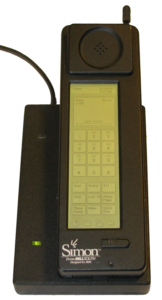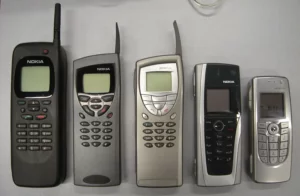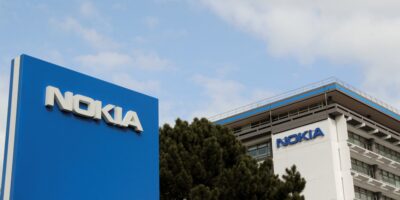
There are over six billion smartphones today, but it wasn’t too long ago –29 years ago – when IBM gave birth to the world’s first smartphone.Source: Shutterstock
Do you remember the first smartphones?
|
Getting your Trinity Audio player ready... |
- The first smartphone, by IBM, was born 29 years ago
- Nokia’s first smartphone could also pass as the forefather of today’s smartphone.
Smartphones are considered one of the most disruptive technologies of the last three decades, revolutionizing how consumers interact with the world. While the first handheld cell phone was born in 1984, it wasn’t until 1994 that the world’s first smartphones were made available to the public.
The International Business Machines Corporation (IBM) debuted the first smartphone the world has ever seen. Known as the IBM Simon, the smartphone was then dubbed a personal communicator, a device featuring an early touchscreen. It could send and receive emails and faxes, act as a pager, and perform other smartphone-like functions. Then, such a device is considered revolutionary.
Today, there are 6.92 billion smartphones in use worldwide – 29 years after the first smartphones were marketed. Let’s revisit how the first smartphones strived for however long it did.
IBM Simon: The world’s first smartphone

The first credited smartphone Image.
Source: IBM
It was November 23, 1992, at the COMDEX trade show in Las Vegas, where the first smartphone, the Simon Personal Communicator, was initially announced with the code name, Angler. While successful, it wouldn’t be marketed to consumers for another two years.
When IBM Simon Personal Communicator (SPC) finally got released, a refined version of Canova’s prototype became available to consumers. It had a touchscreen, and users could make phone calls and receive faxes and emails. With a price tag of US$1,099, IBM Simon also introduced the first few smartphone apps.
In total, IBM Simon had 11 built-in programs: a to-do list, calendar, calculator, appointment scheduler, electronic sketch pad, world time clock, input screen keyboards, handwritten annotations, and address book, among others. However, IBM Simon’s use was pretty limited – it only worked in 15 US states. And while it wasn’t as bulky as earlier phones, the SPC was still big and boxy.
Businessweek’s profile of the device cites Simon’s weak battery — it lasted around an hour — and the cool factor of svelter and svelter flip phones contributing to Simon’s demise. While the Simon didn’t change the world on its own, selling only 50,000 units in its sub-one-year lifespan was an important demonstration of what was possible.
In the subsequent years, there was a mishmash of technology, where personal digital assistants (PDAs) of the time morphed into a collection of ad hoc smartphone-like devices.
The Nokia 9000 Communicator: The first of many smartphones that stayed
“The office in your back pocket.” That was Nokia’s tagline 27 years ago when it launched a mobile phone that could pass as the forefather of today’s smartphone. The Nokia 9000 was first shared with the world at the CeBIT computer fair in Hanover in 1996 and was launched in August of that same year.

The Nokia 9000 Communicator in its open configuration. Source: Medium
As one of the first smartphones in the world, Nokia 9000 was revolutionary simply because of its unique feature: It could be opened to reveal a keyboard and a black-and-white display with a diagonal of 4.5 inches. “The 9000 Communicator was a smartphone even before the word had been invented,” DW, a German public, state-owned international broadcaster, stated in an August 2021 article.
The 9000 Communicator was the first device to offer a combination of a keyboard, quality screen, and business and internet software in one package. It had for the first time all of the features of a computer on the phone, putting email, web browsing, fax, word processing, and spreadsheets into a single pocketable device.
“The phone had 8bm of memory and a 33MHz processor. The screen was a black and white LCD, with a then-high resolution of 640×200 pixels. The long, thin screen meant it could offer a first: a graphical web browser on a mobile device. If you wanted to check your mail or open a web page, you had to wait about 30 seconds for the phone to go online before content — mostly text — would even start loading at a speed of 9.6 kbps,” DW added.
At the peak of its era, the 9000 Communicator cost at least US$800 (€700) in the US. To be successful, the technology had to wait several years to get smaller, sleeker, cheaper, and easier to use. Unfortunately, Nokia failed to transition to the smartphone market in the early 2010s.

The diminishing size of Nokia Communicators from 1996 to 2004. From left: Nokia 9000, 9110i, 9210i, 9300 and 9500. Source: Medium
What it did successfully then with 9000 communicators was putting all office-related apps on the go – years before Blackberry became the iconic symbol of the mobile professional. “We had exactly the right view of what it was all about… We were about five years ahead,” Former Nokia CEO Jorma Ollia told the Wall Street Journal.
Nokia went on with several revisions of the Communicator over the next few years, adding a color screen, slimming the unit down, and updating the operating system. Eventually, the last Communicator model, the E90, was released in 2007 and was only available in the US as an import.
The first touchscreen smartphone
While Nokia continued to dominate the mobile phone market in the late 90s and early 2000s, another tech company was planning something much bigger which would eventually reinvent the mobile phone industry.
It was in 2007, Apple unveiled the first touchscreen smartphone. The Nokia killer became an instant hit among users, thanks to its compact, user friendly form. Apple would go on to sell 6.1 million units. A sealed 4GB model from 2007 was just sold in an auction for US$190, 372.80, which is about 300 times its original sale price.
READ MORE
- Safer Automation: How Sophic and Firmus Succeeded in Malaysia with MDEC’s Support
- Privilege granted, not gained: Intelligent authorization for enhanced infrastructure productivity
- Low-Code produces the Proof-of-Possibilities
- New Wearables Enable Staff to Work Faster and Safer
- Experts weigh in on Oracle’s departure from adland


